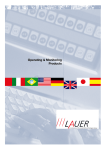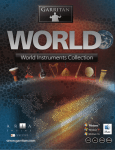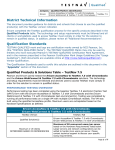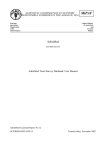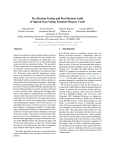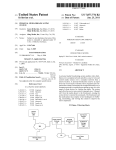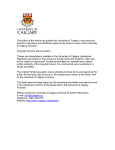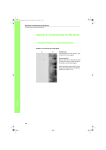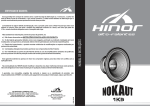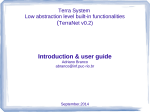Download Internet of Things through Motes
Transcript
Volume 3, Issue 6, June 2013 ISSN: 2277 128X International Journal of Advanced Research in Computer Science and Software Engineering Research Paper Available online at: www.ijarcsse.com Internet of Things through Motes Neethu Prasannan1, Akhil Manikkoth, Gandhiraj R*, Soman K.P. Center for Excellence in Computational Engineering & Networking *Department of ECE Amrita Vishwa Vidyapeetham, India Abstract— In this hectic life schedule of mankind, finding time to refresh has turned out to be an infeasible task. But it is vital for maintaining our productivity, not just in professional life but also in social life. Gardening is surely a leisure time activity which involves both the physical and psychological aspects. On the other hand, it shows justice to our environmental obligation of keeping the planet green. However the practice of gardening needs some sincere investment of our time and care. But we may not always be available to our garden. In this paper we present a smart low cost wireless digital gardening technique. The technique uses an automated system which intimates us about the whole related parameters for keeping our garden nourished. This paper also describes the integration of WSNs with IOT technology and also determining a yield factor which can be used for increasing productivity in similar environments. We can also monitor the soil moisture, temperature, light, pH, and water level through a web interface from any remote location. Thus we can have control over our garden even without being physically present. This spares us from all worries regarding gardening and water scarcity. This paper describes the hardware and software architecture of a fully automated gardening system, which uses motes for data acquisition, aggregation and communication. The paper also discusses the detailed implementation of the system supported by both hardware and software description. Finally, the paper concludes with the performance analysis of system with the previously existing gardening system. Keywords— Wireless Sensor Networks, IOT, Motes, MICAz, TinyOS, Sensors I. INTRODUCTION India is a country in which a good majority of the population depends upon agricultural revenues. The main challenges in the sector are to maintain a good productive despite of the environmental and human challenges. The environmental challenges include the different climatic conditions, proper irrigation, maintaining the acidity or alkalinity of the soil. Another major challenge is the shortage of labor resources. Humanity depends on water and agriculture for survival, so optimal, sustainable and profitable use of our land and water resource are critical. Technology is growing up and today’s technology is capable of automating the whole agricultural systems. Wireless Sensor Networks (WSN) play a key role in it. By using the WSN, we can devise a cost effective and reliable micro sensors which can be used in a large scale to monitor and control the parameters that control the plant yields [1]. Wireless sensor networks can revolutionize soil ecology. The general availability and reduction in the cost of micro sensors and low power wireless communications has enabled the deployment of densely distributed sensor networks for numerous environmental monitoring applications [2]. This system is self-configuring, communication is multi hop and nodes can be used to actuate switches which can be utilized for automated monitoring and controlling functions. This paper presents a smart and low cost gardening system which finds an ultimate solution for the problems regarding water scarcity and agricultural productivity. Being centered around WSN, the system can bring in considerable changes to the agricultural system. WSN is a collection of small, low cost, low power, short range nodes which will work collaboratively to sense and process various physical permits and distribute the data effectively over a network. Wireless sensor device that we have used in our gardening system is motes. Its small size enables its deployment in large areas easily and can be effectively utilized to measure and monitor various environmental parameters like light, temperature, pH, moisture etc. The basic structure of a mote consist of a computational device, a communication platform, a sensing platform and a power source. Various sensors can be connected to these motes and each will act as independent sensor nodes and will sense the physical parameters and process them and can communicate to a central base station. Thus the various gardening and environmental parameters can be accessed from Base station. A structured study of the parameters over a period of time can help us to derive an optimal value of the environmental parameters required for a garden and by making use of these factors, we can increase the yield to a good extend. This paper also presents the integration of WSN with IOT. IOT (Internet of Things) is a network of internet enabled objects [3]. The smart gardening system we present here can be accessed remotely. As we are all well connected to the Internet, we designed this project in such a way that the parameters can be accessed worldwide. The online part is a high performance server which is capable of processing all the values received from the base station, process, store and can visualize the factors in a real time graphical web interface. © 2013, IJARCSSE All Rights Reserved Page | 1698 Gandhiraj et al., International Journal of Advanced Research in Computer Science and Software Engineering 3(6), June - 2013, pp. 1698-1705 II. SYSTEM ARCHITECTURE Our system architecture basically consists of a group of small sensing devices, powered by a limited source of power which collects the information about the physical parameters such as light, temperature, moisture, pH of the soil and the level of reserve water storage. Fig. 1 represents the system architecture. Each node will send the collected data to a central base station or sink node over a wireless channel. The base station is the main mote to which all child nodes report to, and is connected to a PC . The mote-PC communication is made possible by the usage of a powerful Java framework designed by our team. The application is capable of extracting each and every data packets received at the base station, categorize them and store them in a local server which will be updated in real time to an online web server powered by the Internet Cloud. We have designed the system in such a way that the human effort can be minimized to a great extent. The base station -mote network itself acts as an intelligent system which will make sure that the environmental factors are within the optimum limits. No human interference is needed to correct a variation in any of the parameters monitored. If any abnormalities or deficiencies are found, the system initiates the repair mechanism which will eliminate the threats with the help of electro-mechanical devices. Our system can be accessed remotely and thus the user can monitor the garden parameters at any place at any time can monitor the devices through a web connected PC, laptop , tablet or a Smartphone. For the case study we used Aquaponics and gardening system which was set up in our department premisis (Fig. 8). For testing the soil pH and moisture we used a potted hibiscus plant, which requires regular watering . Based on the moisture level watering is done automatically through a mote driven ac motor and thereby minimizing wastage of water. Environmental parametrs like light and temperature is measured around the aquaponics system. The light values are controlled by using a mote based external plant light source . When the light intensity falls beyond the optimum threshold, the lights are powered on. The temperature is regulated using an external fan. Water required for our gardening system is supplied from a tank in which the water level is controlled by a water level indicator. Thus the user can be aware of availabilty of water resources for the gardening system. In short our system consists of 4 sensor nodes, 3 control systems and a web interface. The Web interface records the values for each day and stores it in its database. the data is extracted and is analysed over a period of one month. The data values lead us to the different patterns in which the resources are being used by the plants. From the resultant data we are trying to develop a yield factor, if developed, can be used in a great extent to revolutionize the agricultural sector. Fig. 1 System Architecture III. HARDWARE ARCHITECTURE For our implementation wireless sensor platform we used is MICAz. Data acquisition is done by using the MDA100CB sensor board, which has a thermistor, light sensor and general prototyping area. This prototyping area is used for connecting external sensors, relays and motor. A. Sensor Platform MICAz is a low power mote module manufactured by crossbow technologies limited which operates at 2.4 GH [4]. It basically consist of an IEEE 802.15.4 compliant RF transceiver and a direct sequence spread spectrum radio which is © 2013, IJARCSSE All Rights Reserved Page | 1699 Gandhiraj et al., International Journal of Advanced Research in Computer Science and Software Engineering 3(6), June - 2013, pp. 1698-1705 resistant to RF interference and provides inherent data security. It has a data rate 250kbps. Processor & Radio Platform used is (MPR2400CA) .The MPR2400 is based on the Atmel ATmega128L.This single processor board can do sensing, processing and communication simultaneously. MICAz consist of a 51-pin expansion connector which supports Digital I/O, Analog Inputs, Inter-Integrated Circuit (I2C), SPI and Universal Asynchronous Receive/Transmit (UART) interfaces. Using these interfaces MICAz can be easily connected to a wide variety of external peripherals. Fig. 2 represents a MICAz mote with the MIB520 interface board. B. Sensor Board For connecting the various sensors and control devices to MICAz interface board used is MDA100CB [5], which provides a serial/USB interface . MDA100CB manufactured by crossbow is connected to MICAz via the standard 51-pin expansion connector. The MDA100 series sensor boards have a light sensor/photocell, a precision thermistor, and general prototyping area, that supports connection to all eight channels of the Mote’s analog to digital converter (ADC0– 7), both USART serial ports and the I2C digital communications bus. The prototyping area also consists of 45 unconnected holes which can be used for connecting external sensors and control devices. The MDA100CB sensor board used in our system is shown in Fig.3. C. Interface Board For connecting MICAz mote to the PC we used MIB520 interface board, provides a serial/USB interface for both programming and data communications. Fig. 2 MICAz Mote and MIB520 Interface Board Fig. 3 MDA100CB Sensor Board D. Sensors The sensor board MDA100CB which we are using has an inbuilt light and temperature sensors, which consist of an internal circuitry in which the resistance varies depending upon the sensing values. External sensors we used for our studies are soil moisture sensor, soil pH sensor and a water level indicator. 1) eTape: eTape is a Continuous Fluid Level Sensor, manufactured by Milone Technologies Limited [6]. The eTape's envelope is compressed by the hydrostatic pressure of the fluid in which it is immersed resulting in a change in resistance which corresponds to the distance from the top of the sensor to the fluid surface. The eTape is modeled as a variable resistor (60 – 550 Ω ± 20%). As the liquid level rises, the measured resistance decreases and when the liquid level falls, measured resistance increases. Fig. 4 represents an eTape water level indicator. © 2013, IJARCSSE All Rights Reserved Page | 1700 Gandhiraj et al., International Journal of Advanced Research in Computer Science and Software Engineering 3(6), June - 2013, pp. 1698-1705 Fig. 4 eTape 2) Soil Moisture and pH tester: Soil moisture and pH tester are manufactured by Takemura Electric Works LTD [7] for garden and home use. It can be used either as a moisture sensor or pH sensor by using the switch DM-15. When Dm-15 is pressed it act as a pH sensor, and when depresses it acts as a soil moisture sensor. Meters metallic electrode surface. Before using for gardening purpose usefulness of the soil should be tested. It is necessary to neutralize the soil, which make it absorb manures effectively. This is done by adding lime to it. But when the amount of lime content in soil increases, manganese will be depleted. So before gardening, it is very necessary to measure the pH content of the soil, which shows the hydrogen-ion content. Soil moisture is also very important. Each plant requires a different amount of water. So watering should be done by according to water requirement. Fig. 5 represents the soil moisture and pH sensor. Moisture sensor connected to a potted plant is shown in Fig. 9. Fig. 5 Soil Moisture and pH Sensor E. Control devices AC motor, Valve, Relay, Light, Fan. Tabular representation of all hardwares used in our work is shown in Table. 1. IV. SOFTWARE ARCHITECTURE The implementation is done in TinyOS. TinyOS is an open-source lightweight operating system designed by U.C [8]. Berkeley, specifically for embedded systems with low power and very limited resources. It differs from other operating systems in that its design focuses on ultra low power operation. It provides a set of important services and abstractions such as sensing, radio communication, storage and timers. It defines a concurrent execution model. TinyOS applications and systems are written in nesC language. nesC is an enhanced version of C, with features to reduce RAM and code size. TinyOS provides a component model, a concurrent model and an Application programming interface (API). The component model is grounded in nesC, which allows us to write a piece of reusable code which explicitly declare their dependencies. The concurrent model enables TinyOS to support many components. Every I/O operation in TinyOS is split-phase, rather than block until completion, a request returns immediately and the caller gets a callback when the I/O completes. TinyOS has a set of APIs for common functionality, such as reading sensors, sending packets, and responding to events. We have to write two programs, One is the main program and another is the wiring program. V. Web Interface The web backend is powered by PHP and Java [9]. The data is stored in a Mysql database and is synced with the base station at regular intervals or in real time. The web interface is a powerful script which can decrypt the messages coming from each sensor node and can interpret the data and display it as per our needs. The data are plotted as a graph and is displayed on the main page. It also displays the real time status of all the sensor nodes connected to the base station. It is capable of recording the values of temperature, the pH of soil, water level, and other parameters. The web interface is built in such a way that the value gets updated on each and every second. A typical snapshot of our web interface designed for TinyOS application is shown in Fig. 6. © 2013, IJARCSSE All Rights Reserved Page | 1701 Gandhiraj et al., International Journal of Advanced Research in Computer Science and Software Engineering 3(6), June - 2013, pp. 1698-1705 Fig. 6 Web interface developed for TinyOS application Fig. 7 showing the light values received using Java Listen tool VI. RESULTS AND CONCLUSIONS Based on the study, we were able to plot the distribution of temperature of the ecosystem, soil moisture, pH of the soil, water level and Light intensity over a period of time. We are collecting the data so that we can develop a Yield Factor which could help to utilize the resources effectively to improve the productivity. Based on our research, we have found that the essential factors needed for the growth of a plant are Good Lighting and Watering. The plant needs to be watered at regular intervals of time . We have grown the same plant in external conditions and found that the yield of the plants cultivated by our technology are high when compared to the reference plant. If proper and regular manures and minerals are supplied the plant can deliver good results. By utilizing the technology of WSN with motes and TinyOS, we have found that, if automated the human labor can be decreased to a greater extent and productivity can be increased by a considerable amount. The test gave us a good opportunity to make use of the technology that can be used for improvising the agricultural community. Typical light values obtained are shown in Fig. 7. Relay board connected to a mote is shown in Fig. 10. Fig. 8 Aquaponics and gardening system set up in our department premises © 2013, IJARCSSE All Rights Reserved Page | 1702 Gandhiraj et al., International Journal of Advanced Research in Computer Science and Software Engineering 3(6), June - 2013, pp. 1698-1705 Fig. 9 Moisture sensor connected to potted plant © 2013, IJARCSSE All Rights Reserved Fig. 10 Mote connected to relay board Page | 1703 Gandhiraj et al., International Journal of Advanced Research in Computer Science and Software Engineering 3(6), June - 2013, pp. 1698-1705 Fig. 7 Readings obtained through web interface VI. Future Works We are aiming to extend the project to be an energy efficient project. We are planning to incorporate solar cells for the power source. The motes can be made more energy efficient by making them work in the low power mode and utilizing the maximum of the technology to implement localization and clustering with the motes. We are also aiming at developing the web interface to a next level so that the whole system can be controlled and monitored simultaneously with the help of an Internet connected PDA. We are planning to develop an Android application which can help to send alert messages when certain level of parameters fall behind the threshold value. Acknowledgment We thank Mr. Premanand , Mr. Sachin Kumar, and Mr. Nidhin Prabhakar T.V (Research Associates in CEN, Amrita School of Engineering, Coimbatore), for their assistance in our experimental work. We also express sincere gratitude to Mr. Vinod C. K , for his support in laboratory set up. References [1] Constantinos Marios Angelopoulos , Sotiris Nikoletseas , Georgios Constantinos, “A Smart System for Garden Watering using Wireless Sensor Networks ,” MobiWac’11, October 31–November 4, 2011. [2] Kazem Sohraby, Daniel Minoli, Taieb Znati, A John Wiley & Sons, INC., Publication, “Wireless Sensor Networks, Technology, Protocols, and Applications”. [3] Ji-Chun Zhao, Jun-Feng Zhang, Yu Feng, and Jian-xin Guo, “The Study and Application of IOT Technologies in Agriculture,” 3rd IEEE International Conference on Computer Science and Information Technology (ICCSIT), 2010, Vol. 2, pp. 462-465, July.2010. [4] MICAz data sheet by Cross bow Technology http://www.openautomation.net/uploadsproductos/micaz_datasheet.pdf [5] Crossbow MTS/MDA Sensor Board User's Manual, Revision A, June.2007. [6] MILONE Tecghnologies , etape Continuous Fluid Level Sensor Operating Instructions and Application Notes. [7] Manual for Soil pH and moisture sensor by Takemura Electric Works, LTD. [8] Philip Levis, David Gay, “TinyOS Programming,” Cambridge University Press.oc. ECOC’00, 2000, paper 11.3.4, p. 109. [9] http/:www.neethu.duzzale.com [10] Aitor Hernandez, “Communication Between PC and Motes in TinyOS,” 25, July.2011. [11] David Kohanbash, Anhinav Valada, George Kantor, “Basestation Design and Architecture for Wireless Sensor Networks,” CIGR- Ageng, July. 2012. [12] Jayavardhana Gubbi, Rajkumar Buyya, Slaven Marusic, Marimuthu Palaniswamia, “Internet of Things (IoT): A Vision, Architectural Elements, and Future Directions ,” coRR, July.2012. [13] http/:www.tinyos.net, visited on April 2013. © 2013, IJARCSSE All Rights Reserved Page | 1704 Gandhiraj et al., International Journal of Advanced Research in Computer Science and Software Engineering 3(6), June - 2013, pp. 1698-1705 Components Table. 1 Hardware components Cost 1 MICAz mote $75 2 MIB520CB $95 3 MDA100CB $120 4 eTAPE (8 inch) $34.99 5 Soil Moisture and pH Sensor Rs. 3000 6 AC Motor $9.9 © 2013, IJARCSSE All Rights Reserved Page | 1705









![[SANTIAGOLITEM.NET]](http://vs1.manualzilla.com/store/data/006051955_1-6793608479d1e718412b318dacd9cbdc-150x150.png)
